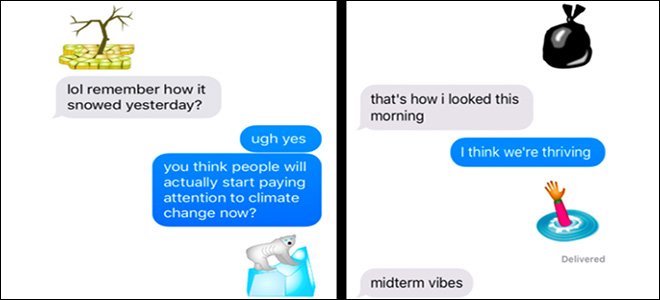
ScienceLine
March 26, 2018
Have you ever felt like a plastic bag, drifting through the wind, wanting to explain to those who threw you away how detrimental you are to the environment? Well, even if you’ve never had that specific urge, it’s a feeling you can now express, like this:

This smiling, slightly passive aggressive plastic bag is a member of a new set of emojis — dubbed Climojis — that highlight the dangers and consequences of climate change. Spearheaded by a teacher in New York University’s Tisch School of the Arts and one of her former students, the Climoji Sticker Pack allows you to express anything from your disgust at plastic waste harming ocean life to generally feeling like a trash bag.

Their creators hope Climojis will help spark everyday conversations about climate change that many people would rather ignore. “At this point, it just seems like climate change is not a part of our daily discourse. It seems like it’s being avoided because it’s a distressing topic,” says Viniyata Pany, a recent graduate of NYU’s Interactive Telecommunications Program who developed the Climojis in collaboration with artist and teacher Marina Zurkow. “With the emojis, we were trying to change that.”
Their project is part of the much bigger trend of emoji creation, which all sorts of marketers and activists are chasing online. And out of the 2.3 billion people who use the Internet worldwide, as many as 92 percent regularly send emojis.
But while emojis may have speedily hijacked the way we communicate online, they are not a new language. Instead, they’re clarifying our emotions. Your smiles, voice inflections and sly winks all disappear when you’re communicating on a screen, making it easy to misconstrue meaning in messages. Emojis fill in the void, revamping and illuminating text.

Climojis are the next line of petite pictures to enter this void. Launched in October through an NYU group called Sustainable ITP, the 27 colorful emojis have already been downloaded by more than 8,000 people.
Their early success might seem surprising, since the climate change conversation in the United States is often divisive, alienating and almost completely devoid of humor. About 69 percent of Americans believe the earth is warming; but only 33 percent ever discuss the issue and just 25 percent say they hear about it weekly in the media, according to the Yale Program on Climate Change Communication. That gap is exactly what Pany and Zurkow set out to shrink. “I’m most interested in finding new, effective approaches to issues of climate chaos and disarming the polarizing conversation,” says Zurkow.

Some of the images are quite dark by emoji standards – a sad penguin or colorless rainbow are a far cry from the dancer emoji. Climate change communication already has a history of attempting to scare the world green with pictures of starving polar bears and a planet doomed to fail. A series of recent studies have suggested that these scary images run the risk of backfiring by deterring people from conversation and action to curb climate change. But Pany hopes that the cartoon-ish horror of the emojis will make people sit up and notice instead of disengaging. “It sort of shakes you a little bit,” she says.

And for every Climoji that frightens you, there’s one that almost makes you giggle — like the trash bag crushing a house or the cow – ahem – excreting methane. You don’t have to feel bad for laughing or sending a Climoji out of context; Pany says it’s fine to send the drowning emoji when complaining about all the work you have to finish. That’s how climate change could slide into the conversation.

Humor as a vehicle for dialogue is currently trending in the United States. Late-night comedians like John Oliver and Steven Colbert are pros when it comes to breaching difficult climate conversations with humor, and recent studies actually support the comedic approach.
It’s a fresh, exciting way to rope people in, says Max Boykoff, who studies climate communication at the University of Colorado, Boulder. When fear doesn’t work to bridge the divide, he says, humor might do the trick. “What they’re doing is innovative and positive towards engagement efforts,” Boykoff adds.
And while even comedy can be divisive, a Climoji keeps the conversation relatively light, despite opposing views, says Vyvyan Evans, a linguist based in the United Kingdom and author of the book The Emoji Code. “It’s very difficult to offend someone using emojis,” he explains. “Because they’re cartoon images, it’s really hard to piss someone off.”

There are still risks, however. Casually throwing, say, a fire faucet into a conversation could trivialize the serious issues, says Boykoff. It could distract instead of enlighten. We’ve already seen this diversion play out in the political arena, where memes and jokes have taken over the conversation but compromise and reform remain stagnant.
“There’s a possibility always where you take something serious and trivialize it,” says Boykoff. “But overall, I think it’s worth the risk.”

Without time and a little research, it’s unclear whether Climoji will change the conversation, says Brigitte Nerlich, an emeritus professor of science, language, and society at the University of Nottingham in the UK. If Climojis do become mainstream, it wouldn’t be the first time an emoji sparked conversation or even controversy. There was a diverse discourse in 2015 when the Apple update introduced the option of changing an emoji’s skin tone. The following year, Apple sparked plenty of online discussion when they banned the hand gun emoji in favor of a lime green squirt gun.
Still, no one thinks the Climojis will work wonders all by themselves. “It’s adding to the conversation,” explains Pany. “They’re humorous invitations to a difficult dialogue.”

But 8,000 Climoji users in five months is, like the cow emoji, nothing to sniff at. The creators want to expand to 10,000 or 15,000 and then try to get picked up by Facebook or even Unicode, allowing anyone with an emoji keyboard direct access without having to download a separate app. The group is also working on a second batch of Climojis, with themes of climate justice and renewable energy, to be released this summer. Pany promises they’ll be more green (and alive) than the current batch.
So, the next time you feel like a trash bag, go ahead: express yourself by pasting a smiling plastic bag floating in the wind into a group chat. You might just get an Earth-changing conversation out of it.


